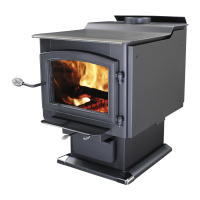
Do you have a question about the Vogelzang International PONDEROSA TR007 and is the answer not in the manual?
| Type | Wood Stove |
|---|---|
| Efficiency | 75% |
| Weight | 250 lbs |
| EPA Certified | Yes |
| Flue Size | 6 inches |
| Firebox Material | Steel |
| Emissions | 3.5 grams/hr |
Details EPA certification, model number, testing labs, and manufacturer branding.
Covers prohibitions on stove modification, proper venting, and clearance rules.
Details chimney safety, ash disposal, and user competence for safe operation.
Covers initial burns, handling, clear areas, high temperatures, and fire hazards.
Addresses door operation, overfiring, fuel loading, duct connections, and room placement.
Covers electrical safety, local codes, permits, and NFPA recommendations.
Lists necessary tools and materials not included with the stove.
Details the step-by-step process for assembling the base skirting and optional blower.
Covers final assembly steps, power cord routing, and connecting to a grounded outlet.
Specifies requirements for floor protectors and clearance zones around the stove.
Illustrates minimum clearance dimensions from combustible surfaces from various views.
Explains the role and assembly of firebricks for heat distribution and stove longevity.
Details required chimney diameter and the critical role of proper draft for operation.
Covers connector pipe types, gauge, mobile home requirements, and installation procedures.
Details mandatory bolting, grounding, structural integrity, and air intake for mobile homes.
Specifies chimney type, height, and general safety rules for mobile home installations.
Explains chimney roles, draft principles, and steps for preparing a masonry chimney.
Details specifications for UL 103 HT/ULC-S629 manufactured chimneys.
Discusses converting existing fireplaces for stove use, including safety and procedures.
Warns against improper fireplace connections and voiding warranties.
Details specific steps for Type A fireplace conversions, including thimble installation.
Specifies clearances for brick masonry and Canadian wall pass-throughs.
Details clearance requirements for insulated sleeves and ventilated thimbles.
Outlines requirements for chimney section pass-throughs, including air space.
Covers safety, explosion hazards, handling hot surfaces, and acceptable fuel types.
Details what wood to burn, fuel seasoning, and materials that should not be burned.
Discusses efficient fuel consumption, heating values, and stove efficiencies.
Explains procedures for initial burns to cure paint and improve durability.
Details the recommended top-down fire-starting method and air control adjustments.
Guides on safely adding fuel and using visible smoke to gauge combustion efficiency.
Provides advice for efficient operation and explains the principles of chimney draft.
Details causes of chimney fires, inspection needs, and emergency response procedures.
Discusses atmospheric pressure, environmental factors, chimney temperature, and maintenance.
Covers air tube function, creosote formation, and steps to prevent buildup.
Details safe ash disposal procedures and the importance of CO monitors.
Provides guidance on cleaning, inspecting, and replacing stove glass safely.
Covers door gasket replacement and maintenance for the optional blower.
Presents the wiring diagram for the optional blower assembly and related safety precautions.
Illustrates stove components and explains how to identify and order replacement parts.
Lists parts for the stove body, heat shields, and internal workings.
Lists control rods, handles, skirts, screws, and other hardware.
Lists glass components, gaskets, and parts for the optional blower assembly.
Details specific components for the stove's door glass and sealing gaskets.
Lists different types of firebricks, their sizes, and the quantities required.
Explains how to convert material specifications to R-value and verify suitability for floor protection.
Provides final remarks on safe stove operation, fire handling, and health.
